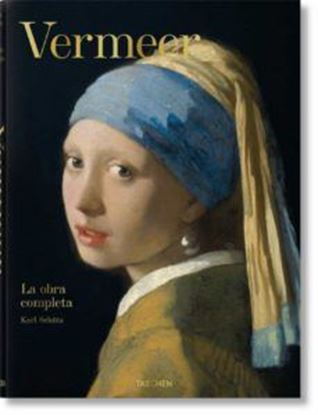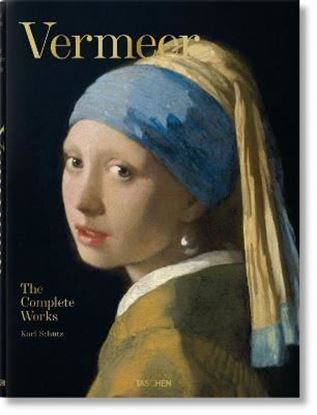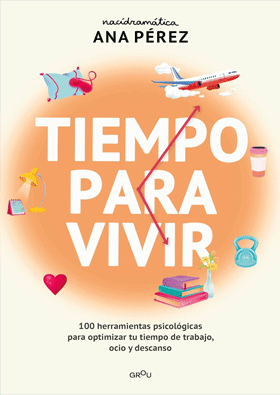

VERMEER. LA OBRA COMPLETA (FP) (E)
En vida, la fama de Johannes Vermeer (1632-1675) apenas sobrepasó las fronteras de su ciudad natal, Delft, y el reducido círculo de sus mecenas. Despues de su muerte, su nombre cayó largo tiempo en el olvido y fuera de Holanda sus pinturas llegaron a atribuirse erróneamente a otros artistas. No fue hasta mediados del siglo XIX cuando Vermeer llamó la atención del mundo del arte internacional que, de pronto, supo admirar su precisión narrativa, la meticulosidad de los detalles de sus texturas y los majestuosos planos lumínicos. Habían descubierto a un genio.
5,995
4,796
VERMEER. THE COMPLETE WORKS (40) (GB)
Despite numbering at just 35, his works have prompted a New York Times best seller; a film starring Scarlett Johansson and Colin Firth; record visitor numbers at art institutions from Amsterdam to Washington, DC; and special crowd-control measures at the Mauritshuis, The Hague, where thousands flock to catch a glimpse of the enigmatic and enchanting Girl with a Pearl Earring, also known as the “Dutch Mona Lisa”.
In his lifetime, however, the fame of Johannes Vermeer (1632–1675) barely extended beyond his native Delft and a small circle of patrons. After his death, his name was largely forgotten, except by a few Dutch art collectors and dealers. Outside of Holland, his works were even misattributed to other artists. It was not until the mid-19th century that Vermeer came to the attention of the international art world, which suddenly looked upon his narrative minutiae, meticulous textural detail, and majestic planes of light, spotted a genius, and never looked back.
This 40th anniversary edition showcases the complete catalog of Vermeer’s work, presenting the calm yet compelling scenes so treasured in galleries across Europe and the United States into one monograph of utmost reproduction quality. Crisp details and essays tracing Vermeer’s career illuminate his remarkable ability not only to bear witness to the trends and trimmings of the Dutch Golden Age but also to encapsulate an entire story in just one transient gesture, expression, or look.
1,995
1,596
VERMEER. THE COMPLETE WORKS (GB)
His works have prompted a New York Times bestseller; a film starring Scarlett Johansson and Colin Firth; record visitor numbers at art institutions from Amsterdam to Washington, DC; and special crowd-control measures at the Mauritshuis, The Hague, where thousands flock to catch a glimpse of the enigmatic and enchanting Girl with a Pearl Earring, also known as the “Dutch Mona Lisa”.
In his lifetime, however, the fame of Johannes Vermeer (1632–1675) barely extended beyond his native Delft and a small circle of patrons. After his death, his name was largely forgotten, except by a few Dutch art collectors and dealers. Outside of Holland, his works were even misattributed to other artists. It was not until the mid-19th century that Vermeer came to the attention of the international art world, which suddenly looked upon his narrative minutiae, meticulous textural details, and majestic planes of light, spotted a genius, and never looked back.
6,700
5,360
VICTORIA HAGAN. LIVE NOW
As an acclaimed interior designer and member of the AD100 and the Interior Design Hall of Fame, Victoria Hagan had achieved the highest pinnacle of success in her field. But when 2020 arrived, she found herself, like all of us, at home, seeing her life and her space with fresh eyes. The result is this book a creative manifesto and a life-affirming look at the nature of home, and how it connects and calms us, comforts and nourishes us. Beautifully designed with a luxurious oversize package that includes gatefolds, Live Now celebrates the quiet and extraordinary beauty of the everyday. Open windows beckon, through which we glimpse the ocean, its hues echoed in the interior palette. A chair for reading waits on a patio, overlooking an expanse of hills. Fresh corn and strawberries from the farmers market tumble over a kitchen table. The 12 dwellings featured in Live Now may range in style, but all share the soothing, light-filled palette, serenity of mood, and aesthetic rigor for which Hagan is renowned, as well as a deep connection to their surroundings, from Sonoma to Palm Beach, Manhattan to Martha s Vineyard.
2,800
2,240
VIDAS DE LEE MILLER
Mujer de gran belleza y personalidad cautivadora, y fotógrafa excepcional, Lee Miller fue, por encima de todo, una aventurera.
En los años veinte, fue chica de portada de Vogue en Nueva York. Lo dejó todo para abrazar París, la fotografía y el surrealismo. Y no fue su última mutación dramática: se reinventó como corresponsal de guerra y llegó a documentar la liberación de Dachau.
Estas son solo tres de las muchas vidas de Lee Miller narradas por su hijo, Antony Penrose. Este íntimo relato ofrece una selección de sus mejores fotografías y reportajes, así como retratos de sus amigos Picasso, Tanning y Ernst. Penrose rinde homenaje a su madre revelando por fin a la mujer de talento extraordinario que fue en los turbulentos tiempos que le tocó vivir.
1,600
1,280














